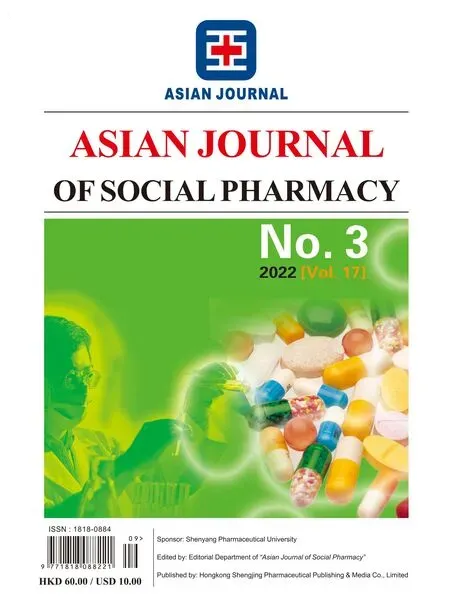Analysis of Factors Affecting Online Drug Purchase -Based on Factor Analysis
Wang Shuling,Liu Liang,Zhi Yuanyuan
(School of Business Administration,Shenyang Pharmaceutical University,Shenyang 110016,China)
Abstract Objective To explore the factors affecting consumers’ online drug purchases,and construct models of these factors to provide references for the development and popularization of online pharmacies.Methods Through searching,classifying,integrating,and extracting evaluation indexes of online pharmacies in literature,the indexes of factors affecting online drug purchases were initially established.Then SPSS24.0 was used for data analysis,and finally factor analysis was applied for screening and combining the indexes.Results and Conclusion A model of influencing factors for online drug purchases is set up with 4 factors and 14 indexes.Convenient service is the most important factor affecting online drug purchases.Highly educated young people prefer to buy drugs online.At present,online drug purchase is only a supplement to the purchase of drugs in offline pharmacies,and the penetration rate is not high.Online pharmacies should give full play to their advantages in terms of drug types,prices,logistics and after-sales services to make online drug purchases more mainstream.
Keywords: online pharmacy;influencing factor;factor analysis
As a special commodity,the stability of drug supply and circulation is the guarantee of the people’s health.China’s drug circulation and supply system is characterized by being scattered,numerous and chaotic.Problems such as high drug prices and difficulties in seeing a doctor have always been plaguing China’s pharmaceutical industry.In recent years,with the vigorous development of online shopping,online pharmacies have emerged as a new industry[1].During the COVID-19 outbreak,online drug purchases became the preferred way for people to buy daily medications.However,as a new industry,online pharmacies will inevitably face some problems.In order to better develop online pharmacies,this paper uses factor analysis to study the influencing factors of online drug purchase from the perspective of consumers,thus making targeted suggestions for the development of online pharmacies.
1 Literature review
1.1 Domestic literature review
Through literature research,it is found that domestic research on “evaluation of online pharmacies” mainly focuses on the behavioral factors that affect online drug purchases,including pharmacy management,services,pharmacy websites,and customer satisfaction.As shown in Fig.1,there were fewer studies on the evaluation of online pharmacies before 2013,and most of them focused on customer satisfaction.After 2013,there were more and more studies on the evaluation of online pharmacies that gradually expanded to other aspects.Most of the researchers used questionnaire survey methods for empirical research.

Fig.1 Summary of domestic online pharmacy evaluation
In terms of research on consumer online drug purchase behaviors,Liang Xinyan,et al.(2015)[2]constructed a consumer online drug purchase behavior model based on the technology acceptance model (TAM) and perceived risk theory through an open questionnaire survey.The analysis showed that the main factors affecting consumers’ online drug purchase behavior were perceived usefulness,perceived ease of use,and perceived risk,which laid a theoretical foundation for subsequent research.Zhen Shouyang,et al.(2015)[3]conducted a questionnaire survey on Tianjin residents and analyzed the results by using SPSS.He found that factors affecting consumers’ online drug purchase behaviors include gender,education background,family income,and online shopping experience.Age has no significant difference on the number of online drug purchases.Fu Fei,et al.(2018)[4]built a structural equation model through a questionnaire survey,which was combined with perceived risk theory and integrated technology acceptance models.He made an empirical research on 382 sample data and found that increasing the popularity of online drug purchase information,providing drug purchase guidance services,sharing consumer evaluation and feedback information,and reducing consumers’ perceived risks can increase customers’ willingness to buy drugs online.Based on SPSS measurement analysis of the survey data of Jiangsu Province,Jia Lilin,et al.(2018)[5]found that the cognition ratio of online drug purchase among Jiangsu residents was as high as 93.8%,and age and gender had a significant impact on the frequency of drug purchase.Qiu Shihan,et al.(2020)[6]found that the factors affecting consumers’ online drug purchase behavior mainly included four aspects through expert research,including drug supply,website construction,pharmaceutical service and after-sales service.Then she constructed an evaluation model of factors affecting online drug purchase behavior based on fuzzy group decision.
Huang Jiaxin,et al.(2021)[7]found that drug quality,after-sales responsibility,privacy protection and pharmaceutical service quality are important indicators for evaluating the service quality of online pharmacies through questionnaire survey.Yu Chongdi,et al.(2012)[8]used a questionnaire survey to explore the impact of online pharmacy payment and aftersales service on consumer psychology,finding that the safety and convenience of online transactions were the main factors that affected consumers’ preferences for purchasing drugs.Meng Lingquan (2013)[9]studied the safety of online drug transactions by using literature analysis,investigation method and analytic hierarchy process.Then he combined it with management,virtual enterprise and other theoretical research to find 8 key factors affecting online pharmacy management,including policy environment,the reputation of corporate integrity,and the awareness of corporate operation,etc.Zhang Xinyan (2016)[10]conducted an index adaptation analysis of the services provided by online pharmacies in China based on the SWRVQUAL scale through expert interviews.And then he quantitatively analyzed the service quality of online pharmacies,finding that the service quality of online pharmacies in China should be improved.Guo Xiaoming,et al.(2017)[11]conducted a customer satisfaction test on 295 online pharmacies consumers by purchasing prescription drugs and over-the-counter(OTC) drugs.After evaluating the management factors of online pharmacies,he found that online payment security and certification of drug transaction service qualifications were the main factors affecting consumer trust.
In terms of pharmacy website research,Yang Shasha,et al.(2013)[12]conducted a survey and analysis of the operating conditions of 66 legal online pharmacies in China based on data from the State Food and Drug Administration website and pharmacy website.She found that most online pharmacies were in economically developed areas like Guangzhou,Shanghai and Beijing.In the same year,she established a three-tier analytic model of evaluation indexes to study the construction and operation of online pharmacies through investigation and research,expert analysis,and case studies.She found that website security was an important foundation for promoting the development of online pharmacies,and thoughtful service was the core competitiveness of online pharmacies.Gao Jie (2015)[13]used the expert interview method to invite 10 experts to rate the quality and operational norms of online pharmacies,finding that the safety,operation speed,and complete drug information of online pharmacies were important factors for the construction of pharmacy websites.Ma Shanshan (2017)[14]conducted a random survey of Chinese netizens through a questionnaire survey method,finding that online pharmacies had some advantages and market potential.Therefore,ensuring the quality of medicines and improving the logistics distribution and service quality can better develop online pharmacies.
In terms of research on customer satisfaction,Wang Shuling,et al.(2007)[15]believed that the establishment of a customer satisfaction evaluation index system for pharmacies should be based on the principles of importance,controllability,measurability,contrast and variability.From the customer’s point of view,the establishment of a hierarchical index structure to evaluate pharmacies as a whole can make the survey results of customer satisfaction more scientific and practical.Yang Jiemin,et al.(2009)[16]analyzed consumer trust in online pharmacies at home and abroad and found that consume environment,legislative perspectives,and supervision and management were the main factors affecting consumer trust in online pharmacies.Wan Hengxing,et al.(2013)[17]analyzed consumers’ online shopping psychology and behaviors by using analogy analysis to explore the influencing factors of customer satisfaction in online pharmacies.He found that the quality of the website,the completeness of product information,whether to provide pharmaceutical services,payment methods and after-sales services were the main factors.Huang Zhe,et al.(2016)[18]used the hotspot mining system structure model,cluster analysis method,and analytic hierarchy process to analyze the online reviews of online pharmacies based on the big data environment,finding that standardized operation,logistics and distribution,and medical insurance connection of online pharmacies were the main factors affecting customer satisfaction.
1.2 Foreign literature review
Foreign scholars have different research perspectives on consumer purchases of drugs in online pharmacies compared with domestic ones.Foreign research mainly focuses on the in-depth analysis of a certain part of the development process of online pharmacies,including the sales of prescription drugs,and supervision of pharmacies,etc.Few literatures systematically explore the factors that affect consumers’online drug purchasing behavior.For example,SM Forsythe,et al.(2003)[19]studied the reasons why consumers were unwilling to shop online by using the theory of perceived risk to investigate the nature of perceived risk related to Internet shopping.Then he proposed to examine the behavior model of Internet users from the framework of perceived risk.C Holtgrafe(2012)[20]proved through research that using the Internet as an information source for OTC drugs would have a positive impact on the choice of unconventional purchase channels for OTC drugs.However,it negatively affected the choice of offline pharmacies.M Mazer,et al.[21]used the cross-sectional data survey method to investigate the online drug purchases of emergency disease (ED) patients,and found that only 5% of the ED patients bought drugs online.Multidisease patients and patients with prescription plans purchased drugs more frequently online.J Brown,et al.(2014)[22]used survey data from 2002 to 2010,starting from the perspectives of prescription drug insurance coverage,the number of prescription drugs and health care expenditures,to have a logistic regression analysis.He found that age,race,income level,insurance coverage,higher medical insurance expenditures and prescriptions were important factors influencing the use of online pharmacies.
2 Research process and results
2.1 Index selection
The indexes in the relevant online pharmacy evaluation literature at home and abroad were classified and analyzed,and we got the frequency table of evaluation indexes for online pharmacies,as shown in Table 1.It can be seen that most scholars believed that indexes such as logistics distribution,drug quality,drug types,and service response speed were important indexes for evaluating online pharmacies,which appeared frequently.
The indexes in Table 1 appear more than two times,indicating that two or more scholars agree with the importance of the index.These indexes are used as standards,and then through expert interviews and discussions,it is decided to select an index with a frequency of more than 2 as the preset index for research and analysis.The specific index assignments are shown in Table 2,and the Likert 5-level scale is used to evaluate the index.

Table 1 Index frequency for online pharmacies

Table 2 Index set
(to be continued)

Continued Table 2
2.2 Data collection
2.2.1 Effective recovery rate of questionnaire
The questionnaire is distributed on the Internet through an App called questionnaire star,and the scope and object of the survey are not limited.According to statistics,when the number of questionnaires is 5-10 times that of the variable questions,the effect is better[23].Based on this,more samples can make the results relatively stable.Therefore,220 questionnaires were issued and 200 valid questionnaires were recovered,with an effective recovery rate of 90.9%.The overall recycling effect is good.
2.2.2 Descriptive statistical analysis
A total of 200 people were surveyed,of which 90 were males and 110 were females,with an even gender distribution.The age distribution is mainly concentrated from 21 to 40 years old,a total of 130 people.There are 42 people under the age of 20,with fewer people in other age groups.In terms of academic qualifications,there are 40 graduate students,84 undergraduates,49 junior college graduates,and 27 senior high school students or below.There are many undergraduates with academic qualifications,and the research is biased towards young and middle-aged people.Among the interviewees,51%have current or previous work or study experience related to the medicine,and 50% have experience in online drug purchases.Therefore,the sample is well representative.Among the respondents,58% believed that online drug purchases were necessary,25% held a neutral attitude towards online drug purchases,and 17% believed that online drug purchases were unnecessary.During the COVID-19 pandemic,65%of people often used drugstores to purchase drugs,23% used online drug purchases,and only 9% used hospital purchases.The statistical results of data mean and standard deviation for all indexes are shown in Table 3.Generally,the average value of the indexes is relatively high,indicating that each index has a certain degree of influence on online drug purchases.
3 Analysis of survey results
3.1 Reliability and validity test
The Cronbach’s coefficientαis used to test the reliability of the index set.The Cronbach’s coefficientαwas proposed by Cronbach in 1951.It is a commonly used reliability analysis standard.The value is normally between 0 and 1.Generally,in order to make the selected evaluation index system more credible,the Cronbach’s coefficientαshould be greater than 0.7,indicating that it is acceptable.The results show that the Cronbach’s coefficientαvalue of the index set is 0.954,indicating that the index set has good reliability.
The KMO test is used to test the validity of the index set.In order to make the selected indexes more credible,an index with a KMO value greater than 0.7 is considered acceptable.If the KMO value is less than 0.7,the selected index needs to be modified.The validity test results show that the KMO value is 0.897,indicating that the index set has good validity.
3.2 Correlation analysis
A bivariate Pearson correlation analysis was carried out on the variables such as the respondents’basic information,drug purchase experience,and the respondents’ drug purchase attitudes.It is found that age,education background,study and work experience,and online drug purchase experience have a relationship with online drug purchase attitude,shown in Table 4.Among them,age,education background,and online drug purchase experience are correlated with online drug purchase attitude whenP≤ 0.001.Study and work experience are correlated with online drug purchase attitude whenP≤ 0.01.
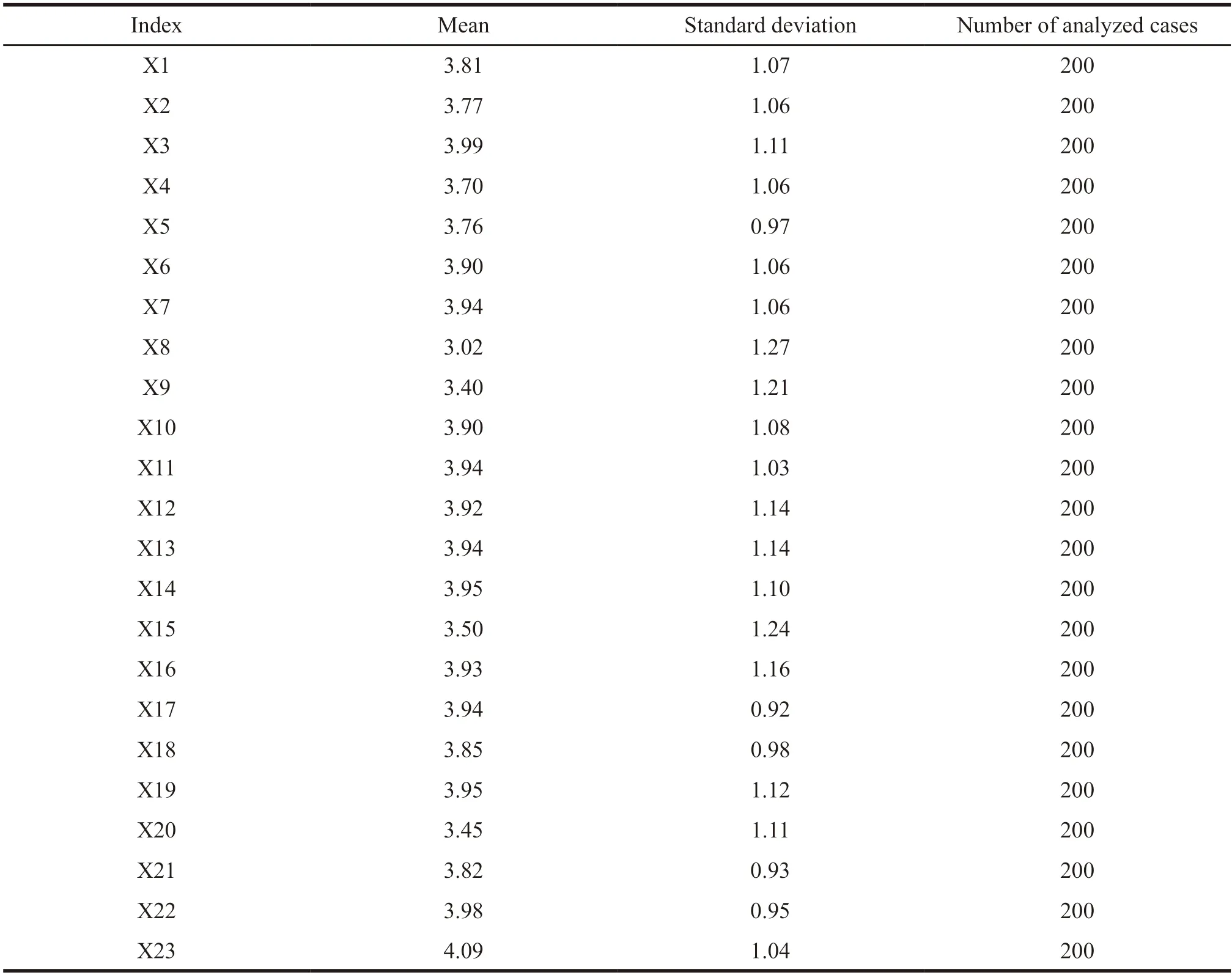
Table 3 Descriptive statistics of index scores

Table 4 Pearson correlation
3.3 Factor analysis
The results of common factor variance extracted by principal component analysis are shown in Table 5.The extraction ratio in the table represents the common factors,which is the ratio of useful information extracted in each index.The more the ratio is extracted,the more useful information the index contains,and the greater the effect of the index on the final result[24].It can be seen from Table 5 that the extraction ratios of all indexes are higher than 0.5,which means the overall indexes have good utility.
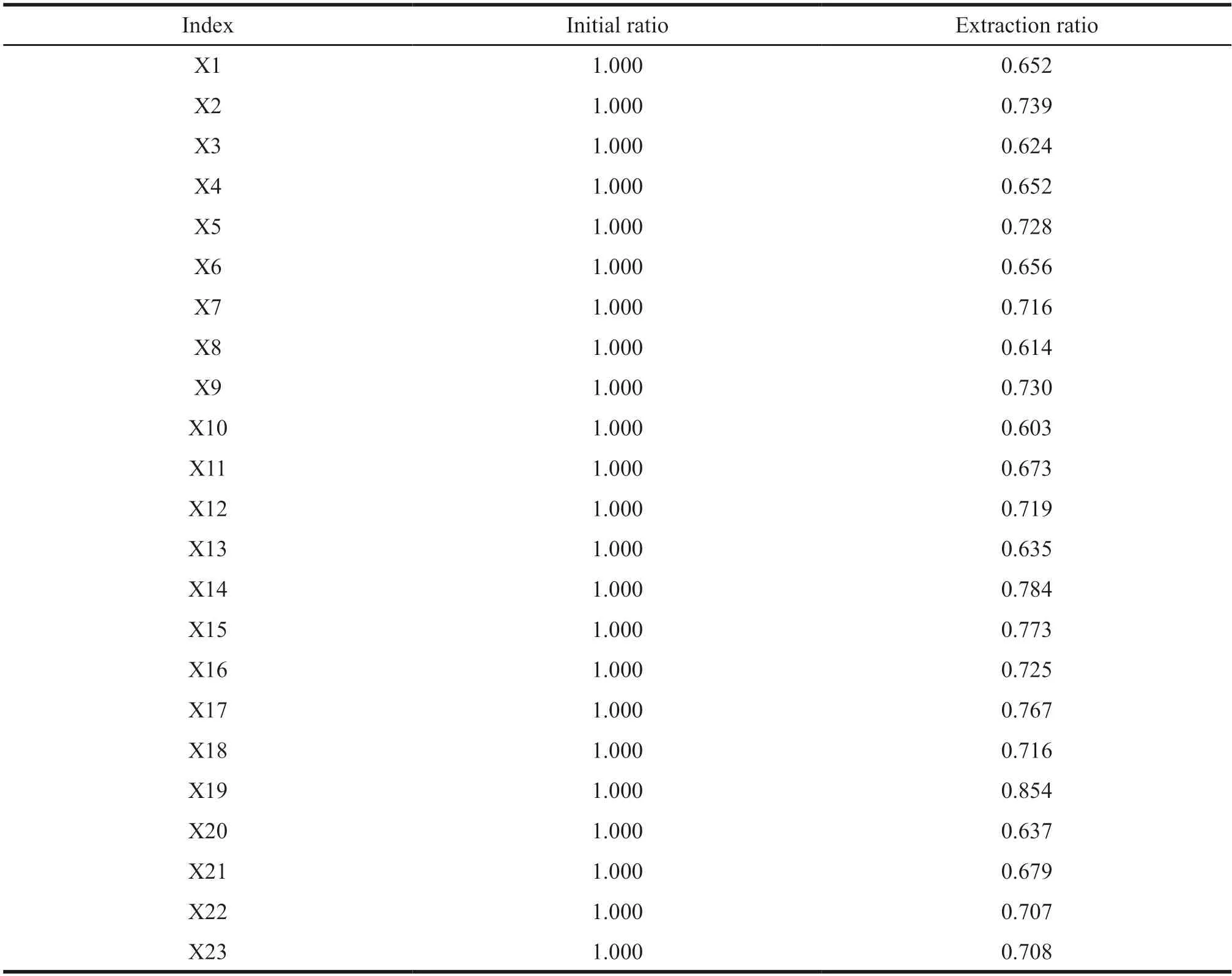
Table 5 Common factor variance
According to the criterion that the eigenvalue is greater than 1,four common factors are finally extracted,and their variance contribution rates are 51.41%,7.28%,6.51% and 4.77%,respectively.Besides,the cumulative variance contribution rate is 69.97% (Table 6).These four main factors basically contain most of the information of the original index.After orthogonal rotation by the maximum variance method,a clear factor loading structure is obtained.The specific factor loading is shown in Table 7.

Table 6 Eigenvalue and contribution rate
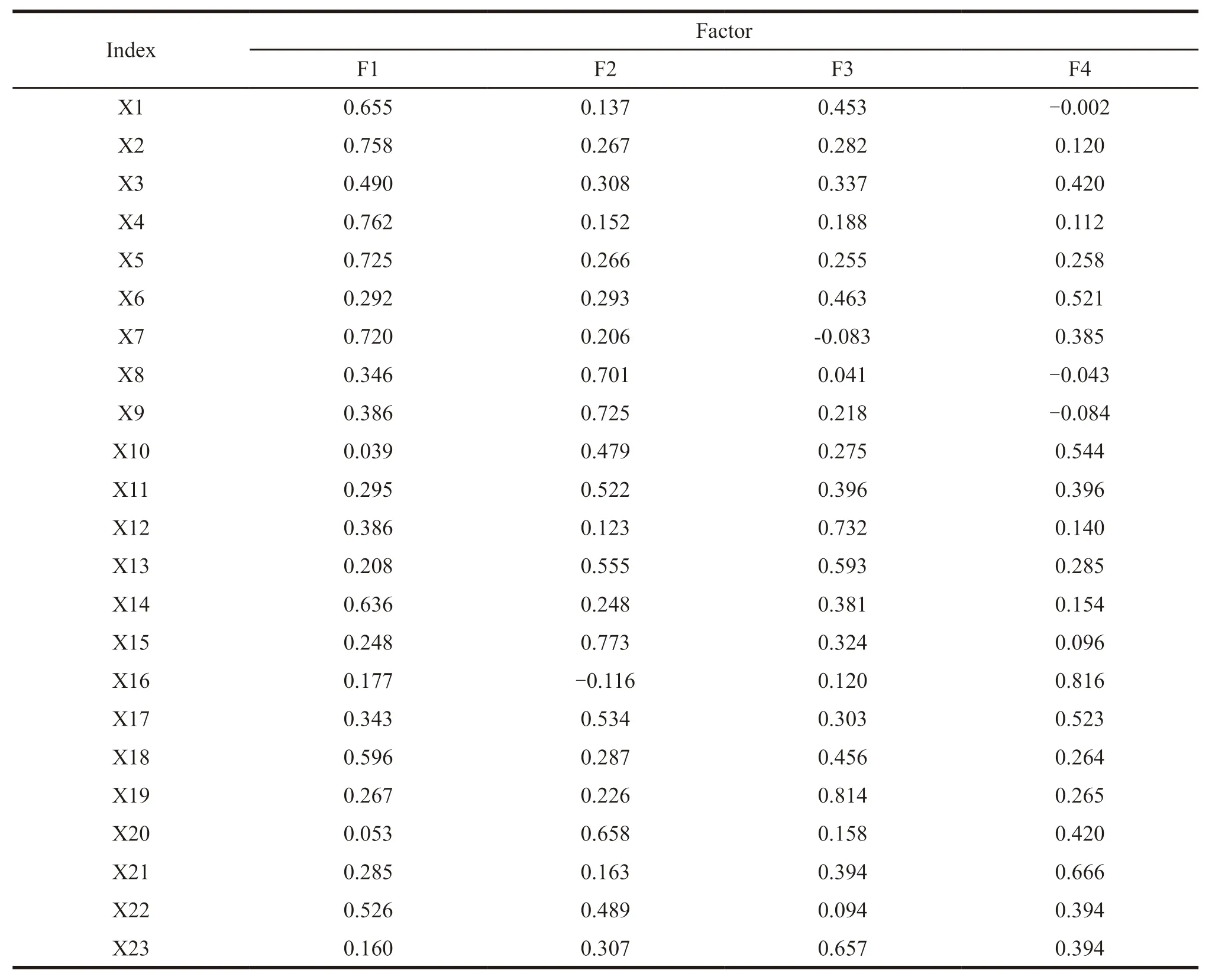
Table 7 Factor loading
Experts such as Mccain,Moya-Anegon and Michael believed that in multi-dimensional factor analysis,each index item should only have a factor loading that is greater than 0.5 in one common factor.In addition,the factor loading in other common factors should not exceed 0.4,otherwise it should be discarded[25].Therefore,the X1,X3,X6,X10,X13,X17,X18,X20 and X22 indexes are discarded,and the final factor loadings after sorting are shown in Table 8.
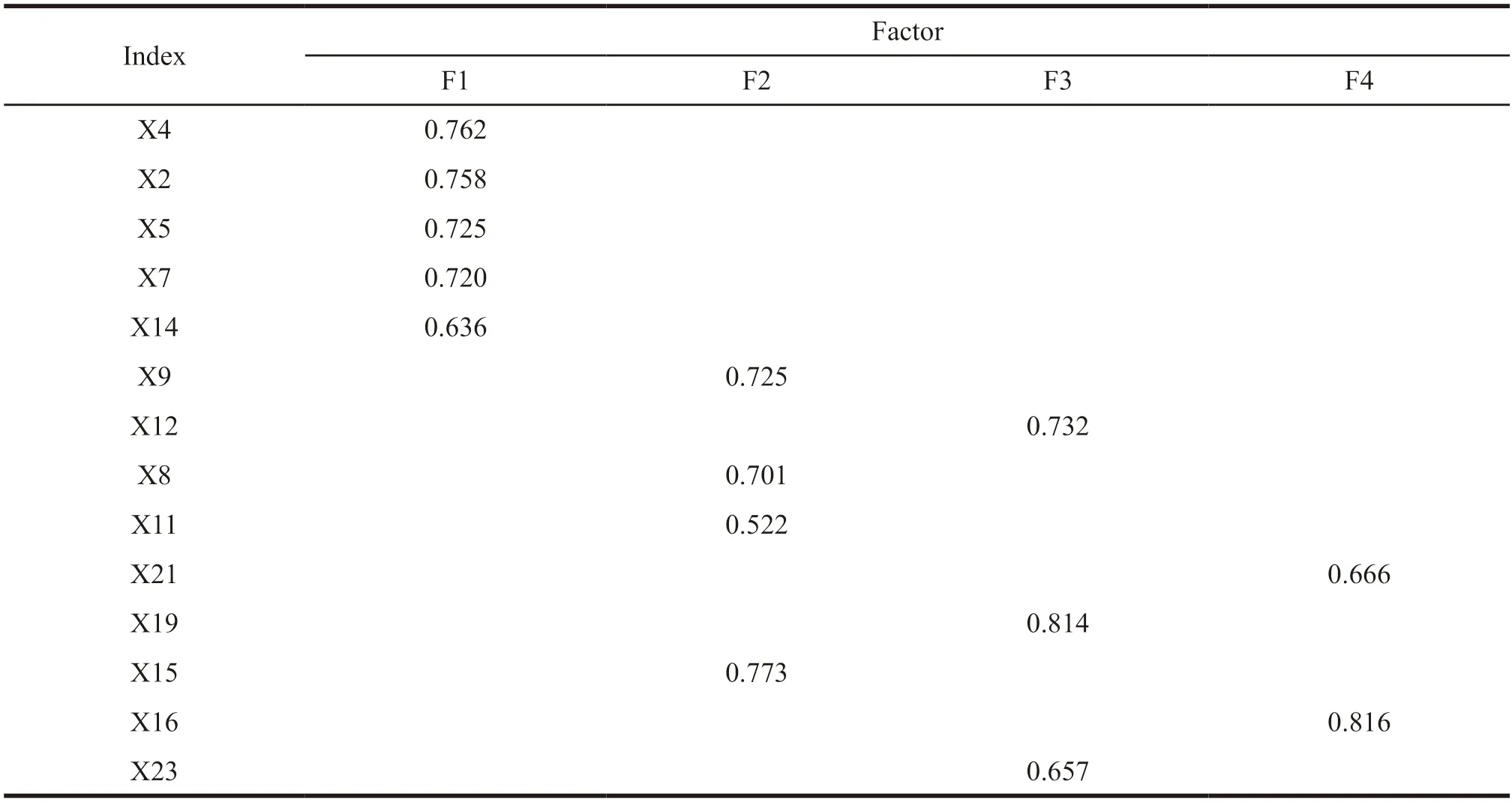
Table 8 Modified factor loading
It can be seen from Table 8 that in the common factor F1,the factor loading is more evenly distributed.Because of the variety of drugs in the online store,the timeliness of logistics distribution,low prices,the good quality of after-sales service,and the convenience and efficiency make online drug purchase index factor loadings larger.Therefore,this factor can be named as a convenient service factor.The common factor F2 contains a large number of website page designs,website stability,drug information display,and online pharmacy brand index factors,so this factor can be named as a brand image factor.The common F3 contains online payment security,website security and privacy protection,which can be named as a network security factor.The common factor F4 has medical insurance reimbursement and policy support for online drug purchase index factors,and this factor can be named as a policy support factor.It can be seen that the influencing factors of online drug purchases mainly include four aspects: convenient services,brand image,network security and policy support.
3.4 Factor weight calculation
After factor analysis,the model framework of factors affecting online drug purchases can be constructed,as shown in Fig.2.The model of factors affecting online drug purchases is composed of 4 factors and 14 indexes.The weight of the firstlevel factor is calculated according to the variance contribution rate of each factor.It means the variance contribution rate of the factor accounts for the proportion of the total cumulative variance contribution rate.The index weight under each factor is calculated according to the factor load of each index,which means the index factor load accounts for the total weight of all index factor loads under the factor.

Fig.2 Model framework of factors affecting online drug purchases
4 Discussion and suggestions
4.1 Most consumers take online drug purchases as a supplement to purchase drugs in pharmacies
Questionnaire survey data show that 58%of people believe that online drug purchases are necessary,but only 23% of people purchase drugs online during the pandemic.This shows that online drug purchases can be accepted by most consumers as a supplement to purchase drugs in pharmacies,and it has not become the mainstream for consumers.Even during the pandemic,not many people purchase drugs online.To some extent,it also reflects the fact that the penetration rate of online drug purchases is not high.Therefore,online pharmacies need to promote their own advantages,such as prompt delivery of the drugs,online drug shopping consultation,and convenience.Only after popularizing consumers’ understanding of the process of online pharmacy purchases,more people can buy drugs online.Consumers who accept online pharmacy or in a wait-and-see state truly believe that online drug purchases can become the mainstream.Consumers who are unwilling to do online drug purchase will gradually change their views and make new attempts.
4.2 Convenience of online drug purchase
As a way of purchasing drugs that reduces physical distance and time cost,online drug purchase has its greatest advantage in convenience,which also attracts consumers’ attention.This can be clearly seen from the analysis of the survey results.The convenient service factor is the most important one affecting consumers’ attitude,accounting for 73.47%of the online drug purchase model.The convenient service factor mainly includes five indexes: the variety of drugs,the convenience of online drug purchases,low prices,the timeliness of logistics and delivery,and good quality of after-sales services.These factors determine the future of online pharmacies.Therefore,online pharmacies should give full play to their advantages in terms of drug types,prices,logistics,and after-sales services.For example,they can provide diverse drug choices,conduct promotional activities to reduce drug prices,use special drug delivery channels in logistics to speed logistics delivery,and offer more high-quality after-sales services (including return and exchange,invoice issuance,and security protection,etc.).This can not only attract more consumers,but increase the chance of customers buying again as well.
4.3 Highly educated young people are the focus
As a new way of purchasing drugs,online drug pharmacy is more likely to be accepted by young people with a high degree of education.According to survey data,80.9% of people under the age of 20 believe that it is acceptable to purchase drugs online,and 74% of the people aged 21-40 think it acceptable to buy drugs online,and most of them have a bachelor degree or above.Compared with people over 40 years old,only 24% of them think it acceptable to buy drugs online,and 66.6% of this group of people have a bachelor’s degree or above.At the same time,it is found that young people with high education have more online shopping experience than other people.For instance,they do more online shopping every week than others.This may also be one of the reasons why young people with high education are more likely to accept online drug purchases.
4.4 The sample is biased towards the young and middle-aged population and has limitations
Due to the limited conditions,the survey samples are mainly from young and middle-aged people,and the results obtained are biased towards the analysis of online drug purchase factors for young and middleaged people.Besides,the influence of regional differences on consumer drug purchase factors has not been fully considered.Therefore,this research has certain limitations.In the future,investigations can be carried out by region,and the model of factors affecting online drug purchases can be gradually improved and revised.
4.5 The influencing factor model can be used for online pharmacy evaluation
The influencing factor model of online drug purchases established in this article can not only explain the reasons why consumers prefer online drug purchases,but also can be used for quality evaluation of online pharmacies.Because the model gives the weights of various factors and indexes,and only a certain method is used,a unified index dimension can evaluate and compare the quality of online pharmacies.In addition,it can also test the disadvantages of online pharmacies from a single index,thus optimizing the indexes.Based on the results,the quality of online pharmacies can be improved to attract more consumers to choose online pharmacies.
- 亚洲社会药学杂志的其它文章
- Benefit-Risk Assessment for PD-1/PD-L1 lnhibitors in the Treatment of Non-Small Cell Lung Cancer
- Research on the Price Level of Drugs in Short Supply in China
- Research on Problems and Countermeasures of Patent Evaluation System in Pharmaceutical Enterprises
- Comparative Study and Enlightenment on lnnovation Achievements of Pharmaceutical lndustry in Liaoning Province
- Research on the Relationship between Cooperation lnnovation Expenditure and Economic Output of China’s Pharmaceutical lndustry
- Development Strategy of Green Marketing of Pharmaceutical Enterprises against the Background of Building a Beautiful China

